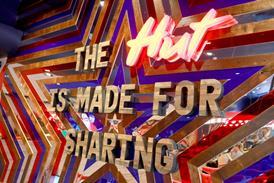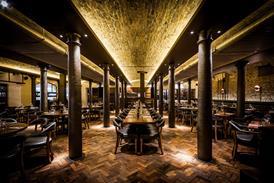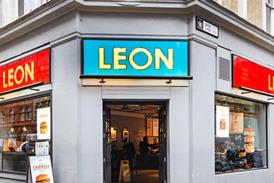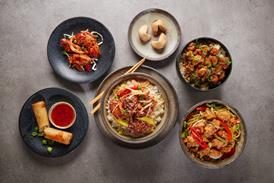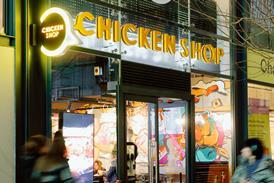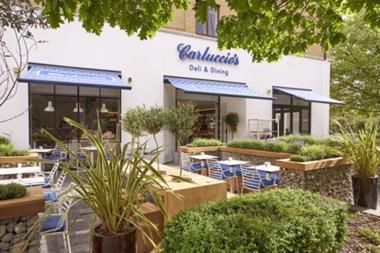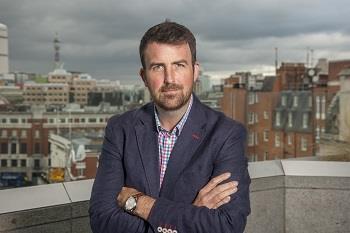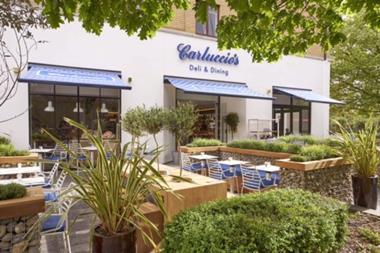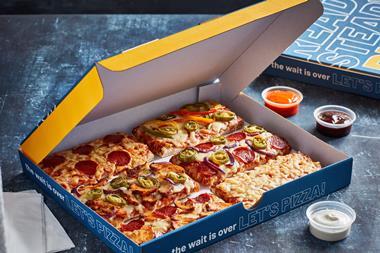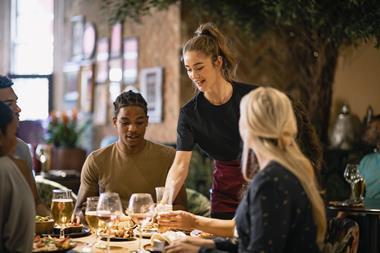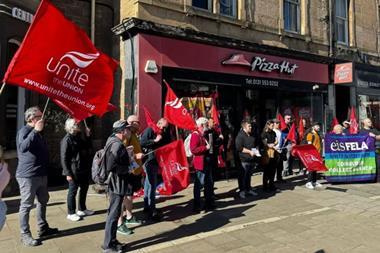The success of Carluccio’s, which has more than 100 stores in the UK and internationally and a turnover of c£140m, is based on a lie. “I promised everyone that we would only open this restaurant (the group’s debut site in London’s Market Place) from 8am til 8pm, because Priscilla Carluccio perceived it as an all-day café,” explains Simon Kossoff,
who stepped down from the company he co-founded in 1999. “We were trading like mad for two hours at lunchtime but we didn’t see a soul across the other parts of the day. So although we were trading in line with our fairly soft budget, it was immediately apparent that unless we changed something fundamental we wouldn’t be successful. So over that Christmas period we reinvented the menu, redressed the restaurant and re-opened on Valentine’s Day 2000. So that’s what we called the ‘Carluccio’s lie’, as I had brought all those people in to work here on the basis that it was hospitality with social hours.”
If that team held it against Kossoff, it didn’t show, as many members have stuck with him during the past 17 years. For the majority of these Kossoff was chief executive and more recently became chairman, with the appointment last year of Neil Wickers, formerly of PizzaExpress, as the new CEO.
As with many success stories,Carluccio’s, which Kossoff founded with Antonio and Priscilla Carluccio, nearly didn’t happen due to lack of finance.
Kossoff says: “The fundraising to start the business was impossible. We built Carluccio’s on the back of Antonio and Priscilla’s deli in Neal Street; it was a tiny shop and made a bit of turnover but only existed with the support of Antonio’s restaurant.
“We thought we had a wonderful idea, and had put together a great team. Antonio had just been on the TV, the idea looked great and so did the feel. We thought we had a great thing but there was no appetite to invest in a business built on bricks and mortar, which planned to grow out of a niche concept. It took us 18 months to raise £2m. The tide turned when we met Scott Svenson, who had just come out of Seattle Coffee Company and is now behind MOD Pizza. Scott was fundamental in fundraising the launch of the concept. He came and saw us at our umpteenth fundraising meeting and at the end of it said he had always wanted to invest in something like this. Within six weeks of him getting involved we had raised the funding we needed.
“It nearly stopped us going forward. I continued to work just in case it didn’t happen. I had given myself six months to make it work, which turned into 18 months. The reason I continued to wait was that the moment that Priscilla showed me tiny elements of the concept she had in mind, I knew it was going to be good. I didn’t know it would take us to where it is today but I knew it had a real chance of some sort of success. That was because it was based on things that become the mantras for businesses – real cooking, great experience. It was a challenge to all the nonsense of those big-themed restaurants, Radio Café, Planet Hollywood etc. So that’s why I allowed it to pass my six- month and even a 12-month deadline.”
Opening more sites
The group’s initial business plan was for 25 sites in five years. Kossoff says: “I didn’t really think at that point about reaching that target, I was focused on opening the first one and seeing if it worked. It was only after we got the Market Place debut site opened that we thought about opening more sites. We went very slowly at first. We opened this site in November 1999 and then waited over a year to launch a concessions unit in Fenwicks Bond Street and then nearly a year after that to build St Christopher’s Place. Looking back at it now we timed it right. We didn’t push up to too much beyond five sites a year until 2008.
“Our problems were around overtrading. Our problem was how do you manage a business that trades from 8am til midnight, has two or three menu offerings and has a shop at the front of it. As soon as we put on the night-time, everything changed. Those shoulder periods that Carluccio’s has been based on started to flesh out. It became a business that was a ‘bucking bronco’ that we were struggling to manage and control, certainly from a P&L perspective.
“The day we opened here (Market Place) we only had three waitresses, who couldn’t keep up. I ended up running the pass and cleaning glasses, as did the rest of the head office team. Alison Stanton, who is now our property director, came to Carluccio’s in early 2000 to run a few shifts to take the pressure off Sarah Murray who is now the chief operating officer. They have been able to grow fantastically with the business.”
St Albans was the company’s first opening outside London, “there was only us and Wagamama there at the time” points out Kossoff. “We also did Brighton around that time. Gradually we pushed outside the south-east, along the M4 at first. We went into the Oxford Castle development, but after a short honeymoon period that site struggled – it was a shock to us. At one time it was seen as a failure to close a site or sites, but now it is seen as management facing up to issues in the business. The company is north of 100 sites now and we’ve only closed three along the way, which is not a bad ratio. Mostly it has been a location mistake with those three.”
By the mid-2000s, the Middle East was screaming out for Western restaurant
brands and Carluccio’s came on the radar of the Landmark Group, which became its franchise partner for the region, and in
2010 agreed to take over the business in a c£90m deal.
Kossoff says: “They built three restaurants with us and the customer feedback was good, even though they were still trying to get the model right. They felt there was something in it and in the early summer of 2010 they said to us they wanted to be more invested in hospitality and more invested outside of the region. Out of that conversation came the takeover in October of that year. They have gone on building the brand in the region. Their judgement to invest outside of their region has proven wise due to the issues facing the Middle East and they have been very supportive since they became involved. It is a family-owned business, a husband and wife team that have built a multi-billion-dollar company over a period of 40 years. They do exit investments, but for me they are building a family legacy.”
Expansion into the US
According to Kossoff, in terms of the history of the business, the plans to make further inroads internationally came from Landmark investing in the business. He says: “They think about going to a new country as I would think about expanding into Manchester or Edinburgh. I think it was always the case with them as the owner that we would take more international steps. We started researching and made visits to the Far East, the US and South America and concluded broadly that we could get a Carluccio’s to work in most of the markets, but the only one where we felt we had a chance of repeating something similar to what we had done in the UK, was the US. Could we open 10 Carluccio’s in Hong Kong? Maybe. Some in Bangkok? Possibly, but the only place where you could think about hundreds of sites is the US. We were persuaded of that and Landmark were also persuaded, so we decided to give it a shot. By that time, I felt very strongly I didn’t want to do stuff in a joint venture, we were much better off running it on our own terms. When you take away the need for funding in those situations, and we are very cash generative and well backed by Landmark, then you just need to hire local expertise rather than enter an agreement with a local partner.
It has been a slower journey that I expected and there is still tonnes of work to do there, but the fundamental thing we have proven is that all those ideas about UK concepts not being acceptable to a US market for Carluccio’s just aren’t true. For example, we have had no push back on portion size. The people challenge is the biggest thing for us, hiring the right people. The pool for good people is not as big as I thought.”
If there was one thing Kossoff would have done differently it would have been to be “a bit more aggressive in the middle years”.
He says: “Once we had discovered we could run these things and built 10 of them, I think we should have pushed a bit harder at that point. I was stuck in my mind around building only five a year. We went to the City and floated on that basis, but I think there was the opportunity to push a bit harder and add more value during that period. We were frightened of killing the golden goose.”
Although he doesn’t like the word legacy, he realises that every store the group opened during his time “has my stamp on it in some way”, and that is the same with the people.
Kossoff, who led the group’s fundraising for Action Against Hunger, which currently stands at c£2m, says: “There are people in this business who I feel have something about them, like Sarah the COO, who was a graduate trainee for me at My Kinda Town and then a restaurant manager. I promised she could manage the first Carluccio’s and when we had more she could run more, and now she is the COO. That is a wonderful legacy. Alison came in to run shifts at Market Place and is now the property director, building a dozen sites a year.”






